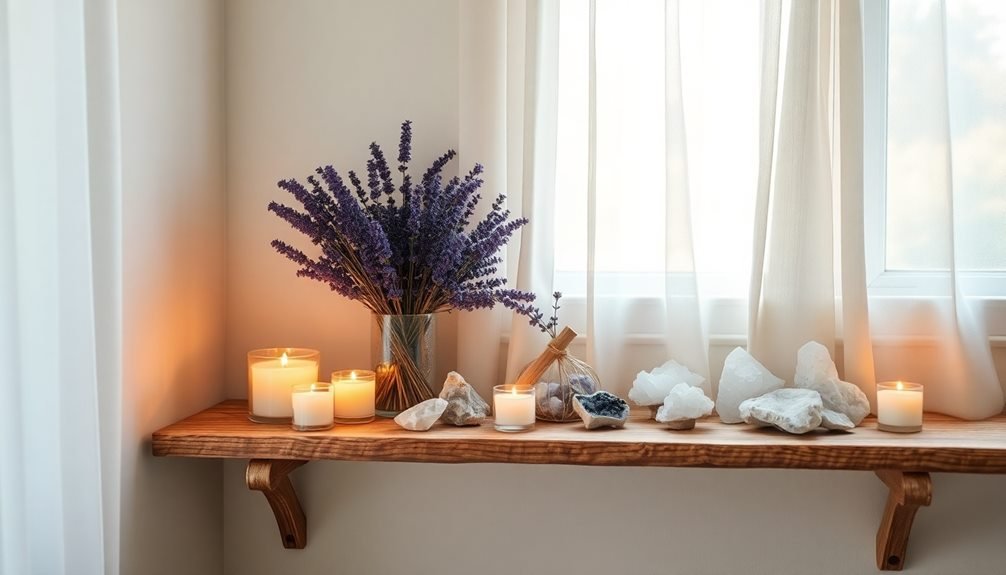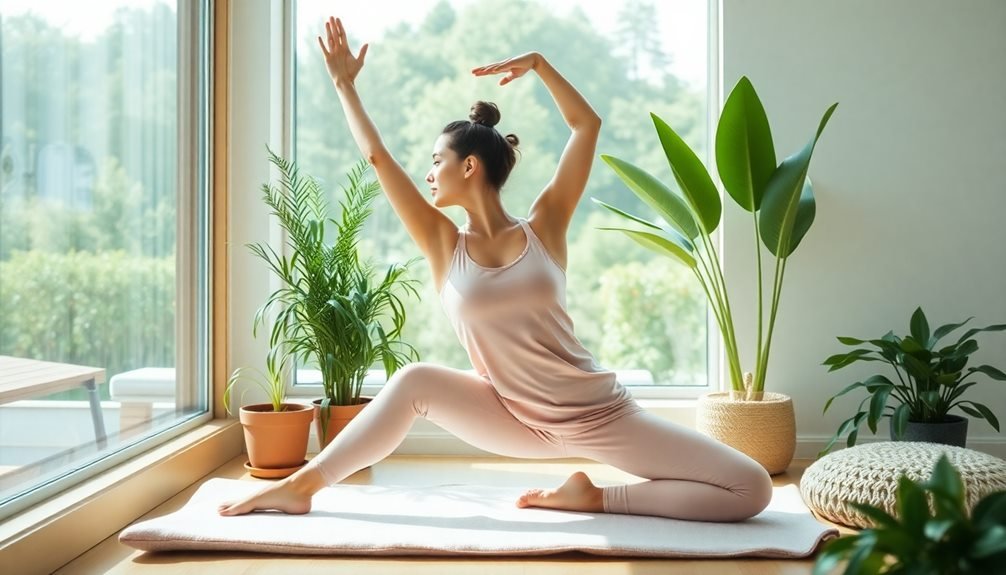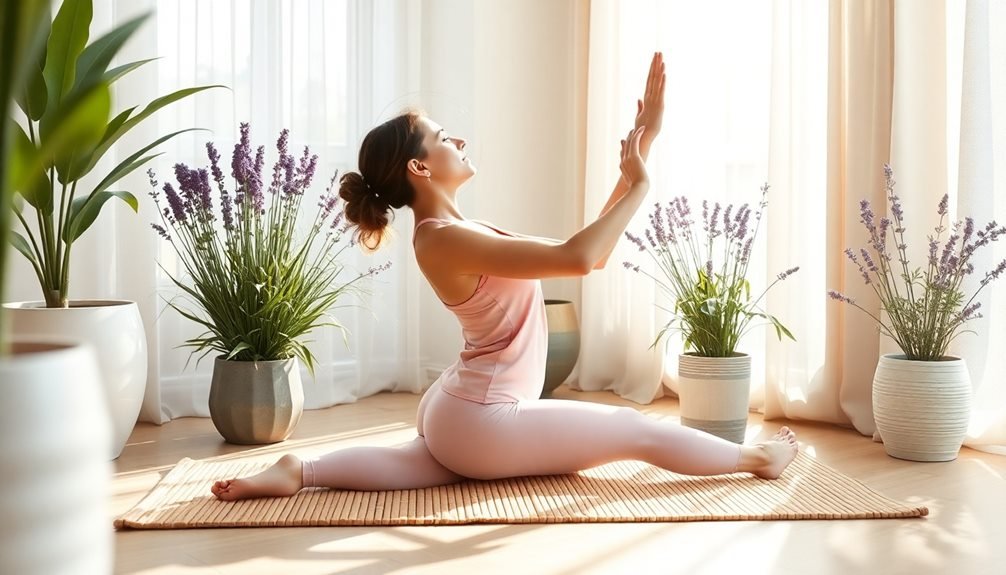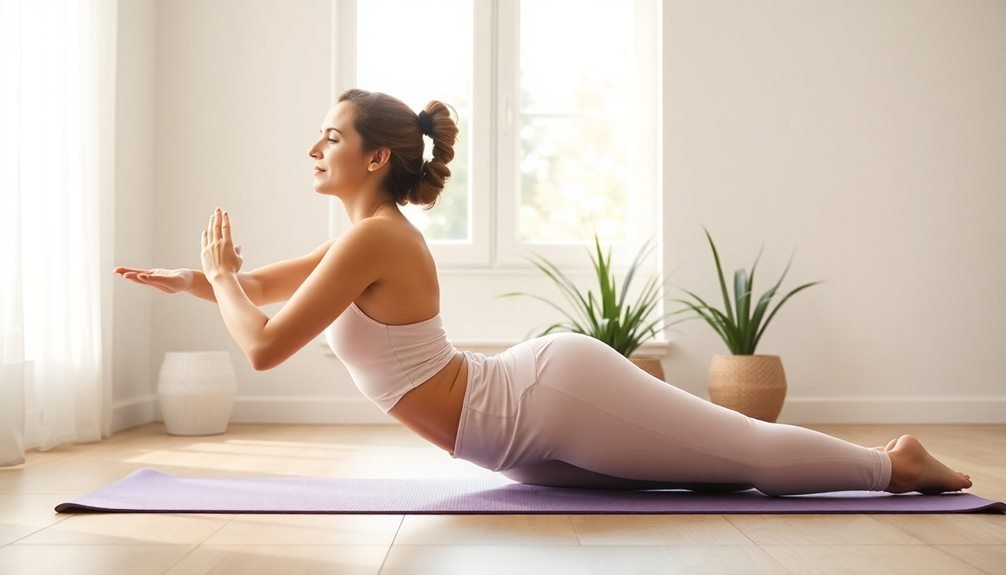Transform your home into a peaceful sanctuary through intentional DIY projects that engage all your senses. Start by selecting a quiet corner near natural light, adding soft textiles and calming colors like blues and greens. You'll create tranquility by incorporating natural elements – try arranging river stones, setting up a small fountain, or adding air-purifying plants like peace lilies. Enhance the atmosphere with homemade aromatherapy using essential oils and dried herbs, and maintain serenity through purposeful decluttering. Whether you're crafting mindful wall art or designing a meditation nook, each thoughtful addition brings you closer to your inner peace journey.
Creating Your Sacred Space

Your home's most peaceful corner deserves thoughtful attention and purpose. Start by selecting a quiet spot away from high-traffic areas, ideally near natural light. This space will become your sanctuary for meditation, reflection, or simply unwinding after a long day.
Clear the area of clutter and unnecessary items, leaving only elements that spark tranquility. Add a comfortable cushion or floor pillow as your anchor point, and position it facing east if possible, following ancient meditation traditions.
Layer soft textures with a small wool rug or woven mat to define the space's boundaries. Incorporate nature by adding potted plants like peace lilies or snake plants, known for their air-purifying properties.
Include meaningful objects that ground you—perhaps a special crystal, a family heirloom, or a cherished photo. Consider hanging lightweight, natural-fiber curtains to filter harsh light and create a sense of enclosure.
Add gentle lighting with Himalayan salt lamps or battery-operated candles for safety. Keep a small basket nearby for essentials like meditation beads, journals, or inspirational books.
Mindful Color Selection
Choosing the right colors for your home can greatly impact your emotional well-being and create a tranquil atmosphere.
You'll find that cool blues and soft greens work well in bedrooms and bathrooms, while warm neutrals like sandy beiges and gentle grays promote relaxation in living spaces.
Your color choices should reflect the intended mood of each room, as certain hues can energize, while others help you unwind.
Soothing Palettes For Serenity
Through mindful color selection, you'll discover that creating a serene space starts with the right palette. Soft blues and gentle greens reflect nature's calming influence, while muted grays serve as versatile neutrals that won't overwhelm your senses. Paint your walls in these soothing hues to establish a peaceful foundation for your sanctuary.
Layer your chosen colors using the 60-30-10 rule: 60% should be your main color (walls and large furniture), 30% your secondary shade (textiles and accent pieces), and 10% your accent color (decorative elements).
For ultimate serenity, combine cool tones like sage green with warm beige or pair dusty blue with soft cream. These combinations create balance without jarring contrasts.
Don't forget about white space – it's essential for visual rest. Include plenty of light, neutral areas to prevent color saturation from becoming overwhelming.
Consider incorporating earth tones like terracotta or sand to ground your space and add natural warmth. Remember, your goal isn't to eliminate color but to choose shades that promote relaxation and tranquility in your daily environment.
Room-By-Room Color Psychology
Color selection routinely impacts our emotional state in different ways throughout the home. Your choice of paint, textiles, and decorative elements can transform each room's energy and influence your daily activities and mood.
In bedrooms, soft blues and lavenders promote restful sleep and relaxation, while muted greens create a natural sanctuary. Your home office benefits from yellows and light oranges, which enhance focus and creativity without overwhelming the senses. For kitchens, warm whites and pale sage tones encourage a clean, appetizing environment while maintaining a calm atmosphere.
When selecting your color palette, consider these room-specific psychological effects:
- Living Areas: Choose warm beiges and gentle earth tones to foster conversation and connection while maintaining a peaceful environment.
- Bathrooms: Incorporate soft aquas and light grays to create a spa-like atmosphere that promotes morning energy and evening relaxation.
- Meditation Spaces: Select pure whites or pale purples to enhance mindfulness and spiritual connection.
Remember to test paint samples at different times of day, as natural and artificial lighting can greatly alter how colors appear and affect your space's overall mood.
Natural Elements for Serenity

Bringing nature indoors creates an instant sanctuary through mindfully arranged river stones, tabletop fountains, and lush greenery.
You'll find that placing smooth stones in geometric patterns or creating a Zen garden can ground your space and promote peaceful contemplation.
Your home's serenity level rises when you combine these elements by surrounding a small water feature with healing plants like lavender, peace lily, or snake plant.
Mindful Stone Arrangements
Nature's timeless stones can transform any space into a meditative sanctuary when thoughtfully arranged.
You'll find that creating intentional stone compositions helps ground your environment while promoting a sense of balance and stability. Start by selecting stones that speak to you – whether they're smooth river rocks, raw crystals, or textured pebbles from your travels.
Position your stones with purpose, considering both aesthetic appeal and energetic flow. You can create powerful arrangements by following these core principles:
- Layer stones in descending sizes to create a natural flow, mimicking the way rocks settle in nature – this draws the eye smoothly across your display.
- Incorporate odd numbers in your groupings, particularly sets of three or five, which naturally feel more balanced and harmonious.
- Combine contrasting textures and colors while maintaining a cohesive theme – mix polished and raw surfaces, or dark and light tones.
When arranging your stones, trust your intuition. You'll know when the arrangement feels right.
Place these mindful compositions in areas where you need grounding energy – your desk, meditation corner, or bedside table.
Remember to periodically cleanse and rearrange your stones to refresh their energy and your space.
Indoor Water Features
While stones offer a solid foundation for mindful spaces, flowing water introduces dynamic movement and soothing sounds to your home environment.
You'll find that adding a DIY water feature can transform any room into a tranquil sanctuary, helping to mask urban noise and create a peaceful atmosphere.
Start with a simple tabletop fountain using a small submersible pump, smooth river rocks, and a ceramic bowl.
You can layer different-sized stones to create natural-looking waterfalls, or opt for bamboo spouts for a zen garden effect.
For a more dramatic statement, consider crafting a wall-mounted water panel using tempered glass and copper tubing.
When designing your water feature, focus on proper water flow – too forceful, and it'll be distracting; too gentle, and you'll miss the calming effect.
You'll need to maintain proper water levels and clean the pump regularly to prevent mineral buildup.
Position your fountain away from electronics and use distilled water to minimize deposits.
Place your water feature where you'll hear it during daily activities – perhaps near your meditation corner or home office – but make certain it's not in a high-traffic area where it might get bumped.
Healing Plant Corners
Living plants serve as natural mood boosters and air purifiers in mindful spaces, making them essential elements for a healing corner. You'll want to select plants that thrive in your specific lighting conditions while requiring minimal maintenance.
Consider incorporating a mix of trailing plants, upright specimens, and compact varieties to create visual interest and depth.
Create your healing plant corner by choosing a quiet spot that receives appropriate light and allows you to interact with your plants daily. Position your green companions at varying heights using plant stands, wall-mounted planters, or floating shelves.
When selecting plants for your therapeutic space, focus on species known for their calming properties:
- Snake plants and peace lilies filter indoor air pollutants while requiring little attention
- Lavender and jasmine release soothing fragrances that promote relaxation
- Pothos and spider plants cascade naturally, adding movement and life to your space
Don't forget to include comfortable seating nearby, allowing you to fully immerse yourself in your green sanctuary.
Add natural elements like stones, crystals, or driftwood to enhance the organic feel of your healing plant corner.
Decluttering With Purpose
Before creating a calming space, you'll need to address the visual noise that clutters your home. Start by dividing your space into three zones: keep, donate, and discard. Focus on one room at a time, handling each item with intention and asking yourself if it serves a purpose or brings genuine joy.
When decluttering, consider the energy flow in your space. Remove items blocking walkways, clear windowsills to maximize natural light, and reorganize furniture to create open pathways.
Don't forget vertical spaces – walls and shelves should display only meaningful items that contribute to your sense of peace.
Create designated homes for everyday items using labeled containers, drawer organizers, and storage baskets. You'll find that having a specific place for each item reduces daily stress and maintains order.
Keep surfaces clear by implementing a "one-in-one-out" rule: when you bring in something new, remove something old.
Remember that purposeful decluttering isn't about achieving perfection – it's about creating breathing room for your mind and spirit.
Store seasonal items in rotation, and schedule quarterly decluttering sessions to maintain your calm, organized space.
Aromatherapy Through DIY Projects

Three simple aromatherapy projects can transform your living space into a therapeutic sanctuary. By creating your own scented elements, you'll maintain control over ingredients while developing a deeper connection to your home's sensory environment.
- Reed diffusers: Fill a glass vessel with a mixture of essential oils and carrier oil, then insert natural rattan reeds. Position these near entryways or workspaces, where their gentle diffusion can instantly affect your mood. Rotate the reeds weekly to refresh the scent.
- Dried herb bundles: Gather lavender, sage, rosemary, or thyme from your garden or local market. Tie them with natural twine and hang them in your shower, where steam will release their calming properties. You can also place these bundles in closets or drawers to naturally scent your clothes.
- Simmering potpourri: Combine citrus peels, cinnamon sticks, star anise, and vanilla pods in a small saucepan with water. Let it simmer on low heat to fill your home with natural fragrance. You'll want to check the water level every hour and replenish as needed.
Remember to choose scents that align with your intended mood – citrus for energy, lavender for relaxation, or pine for focus.
Crafting Personal Meditation Corners
Tranquility begins with a dedicated space for mindfulness and reflection. To create your personal meditation corner, start by selecting a quiet nook away from household traffic.
You'll want to position yourself near a window for natural light while maintaining privacy with sheer curtains or bamboo blinds.
Layer your space with comfort elements: begin with a supportive meditation cushion or floor pillow, then add a soft rug beneath it.
You can build a low platform using reclaimed wood, creating an elevated space that feels separate from the rest of the room. Install wall-mounted shelving for essential items like singing bowls, crystals, or meditation timers.
Consider incorporating natural elements that promote serenity. Place small potted plants like peace lilies or snake plants nearby, or arrange smooth river stones in a shallow wooden bowl.
You'll enhance the ambiance with battery-operated flameless candles and Himalayan salt lamps for gentle lighting.
Mount a small cork board to display inspiring quotes or images, and keep a journal nearby for post-meditation reflections.
Add a small essential oil diffuser to infuse the space with calming scents like lavender or sandalwood.
Healing Crystal Display Methods

Harmony flows naturally when you display healing crystals thoughtfully throughout your space. The key lies in understanding how different display methods can amplify your crystals' energetic properties while creating visually appealing arrangements that complement your home's aesthetic.
Create intentional crystal displays by considering both placement and presentation. You'll want to position larger specimens like amethyst geodes or quartz clusters as striking focal points, while smaller stones can be grouped in sacred geometric patterns or arranged in spiral formations on wooden platforms.
Natural light plays an essential role in showcasing your crystal collection, so consider these display options:
- Glass-topped shadow boxes with velvet linings that protect delicate specimens while allowing you to view them from above
- Tiered wooden stands with multiple levels, perfect for creating energy-flowing arrangements that draw the eye upward
- Hanging crystal mobiles near windows, where sunlight can catch and disperse their natural luminescence
When arranging multiple crystals, trust your intuition about which stones belong together. You'll notice that certain combinations feel more harmonious than others, helping you create displays that aren't just beautiful but energetically balanced.
Sound-Soothing Design Elements
Creating a peaceful soundscape in your home begins with strategic placement of sound-dampening design elements.
You'll want to incorporate soft textiles like plush area rugs, heavy curtains, and upholstered furniture to absorb excess noise. Adding cork wall tiles or acoustic panels can greatly reduce sound reflection while serving as decorative elements.
Consider crafting your own water features using simple materials like ceramic bowls, small pumps, and polished stones. The gentle trickle of water masks disruptive background noise and promotes relaxation.
You can also hang wind chimes near windows or create macramé wall hangings that subtly move with air currents, producing soft, melodic sounds.
For maximum sound absorption, build a living wall using potted plants in varying heights and textures. Plants naturally dampen noise while purifying the air.
Don't forget to position bamboo screens or room dividers strategically – they'll help break up sound waves and create distinct zones within your space.
If you're crafty, try making your own textile art pieces using thick wool or cotton fibers, which will add both visual interest and acoustic benefits to your walls.
Living Plant Arrangements

Natural plant arrangements serve as living focal points that bring serenity to any room. You'll find that strategically placed greenery can transform your space into a calming sanctuary while purifying the air you breathe.
By combining different heights, textures, and leaf patterns, you're creating visual interest that draws the eye and soothes the mind.
When designing your plant arrangements, consider grouping plants in odd numbers and varying their sizes. You'll want to select specimens that thrive in your home's specific lighting conditions and match your care commitment level.
Create depth by placing taller plants behind shorter ones, and use decorative containers that complement your existing décor.
For maximum impact, try these arrangement styles:
- Vertical gardens using wall-mounted planters filled with cascading pothos, ferns, and air plants
- Tabletop terrariums featuring low-maintenance succulents and miniature cacti
- Grouped floor arrangements combining snake plants, peace lilies, and rubber plants
Remember to maintain consistent watering schedules and proper drainage to keep your living décor healthy.
You'll find that tending to your plants becomes a mindful ritual that enhances your home's peaceful atmosphere.
Mindful Wall Art Creation
Personalized wall art serves as a meditative outlet while transforming your living space into a tranquil retreat. When you create your own mindful wall pieces, you'll engage in a therapeutic process that brings both artistic satisfaction and emotional release.
| Material Options | Mindful Techniques |
|---|---|
| Canvas & Acrylics | Circular Mandala Painting |
| Natural Fibers | Weaving Meditation |
| Pressed Flowers | Nature Collage |
| Watercolors | Flow State Abstracts |
| Recycled Paper | Zen Paper Folding |
Start by selecting materials that resonate with your sense of calm. You'll find that natural textures and soothing colors work best for mindful creation. As you work, focus on your breathing and let your hands move intuitively across your chosen medium.
Consider creating a dedicated space for your mindful art practice, where you can return whenever you need to center yourself. Whether you're painting gentle watercolor washes or weaving natural fibers, maintain a slow, intentional pace. Your finished pieces will carry the peaceful energy of your creative process, making them powerful additions to your calm home environment.
Textile Therapy Projects

While working with textiles can soothe your mind, mindful weaving offers an especially meditative way to create beautiful wall hangings using simple lap looms and natural fibers.
You'll find peace in methodically transforming repurposed fabrics into new art pieces, whether you're braiding old t-shirts into colorful rugs or quilting memory blankets from cherished clothing.
These hands-on textile projects let you practice mindfulness while crafting meaningful decor that brings both visual interest and emotional comfort to your space.
Mindful Weaving Practice Tips
Mindful weaving consistently offers a therapeutic escape from daily stresses while creating beautiful textile art. As you begin your weaving practice, focus on selecting yarns and fibers that feel soothing to touch, considering both texture and color harmony.
Set up your loom in a quiet space where you can maintain proper posture and breathe deeply throughout your practice.
To enhance your mindful weaving experience, incorporate these essential techniques:
- Establish a rhythm with your breathing – inhale as you pass the shuttle through the shed, exhale as you beat the weft into place
- Count your threads deliberately while warping, using this time to clear your mind of external thoughts
- Notice the tactile sensations of different fibers and how they interact with each other
Concentrate on each movement's intention, from threading the heddles to adjusting tension. If your mind wanders, gently return your focus to the repetitive motions of weaving.
Keep your movements slow and purposeful, allowing the systematic nature of weaving to ground you in the present moment. This meditative approach transforms a creative activity into a calming ritual that produces both inner peace and tangible artwork.
Repurposed Fabric Art Ideas
Creating textile art from repurposed fabrics offers a sustainable way to transform cherished materials into meaningful decor while practicing stress relief. You'll find that working with familiar textiles, like old clothing or linens, connects you to memories while crafting something new and beautiful for your space.
| Project Type | Materials Needed |
|---|---|
| Memory Quilt | Old clothing, batting, thread |
| Wall Hanging | Fabric scraps, dowel rod, twine |
| Fabric Wreath | T-shirt strips, wire form, scissors |
| Textile Collage | Various fabrics, canvas, glue |
| Rope Basket | Fabric strips, clothesline, thread |
Start by selecting fabrics that speak to you emotionally—perhaps your child's outgrown clothes or your grandmother's tablecloth. Cut your chosen materials into workable pieces, focusing on the mindful process of deconstructing and reimagining. You can create intricate wall hangings by weaving strips into geometric patterns, or design a memory quilt that tells your family's story through fabric. For smaller projects, try making coiled fabric bowls or braided rugs that add texture to your space while providing a meditative crafting experience.
Light and Shadow Balance
The dance of light and shadow plays an essential role in crafting a peaceful home environment.
You'll find that strategically placing light sources at different heights creates depth and dimension, while thoughtfully positioned shadows add mystery and calm to your space.
By understanding how natural and artificial light interact with your room's architecture, you can transform ordinary spaces into tranquil sanctuaries.
Consider incorporating these light-balancing elements into your DIY decor:
- Layer your lighting with a mix of floor lamps, table lamps, and pendant lights to create adaptable atmospheres for different moods and times of day.
- Install dimmer switches on overhead lights and use frosted bulbs to soften harsh shadows, allowing you to adjust the room's energy as needed.
- Position mirrors and reflective surfaces strategically to bounce light into darker corners while creating interesting shadow patterns.
You don't need to eliminate shadows completely – they're vital for depth perception and visual interest.
Instead, focus on creating a harmonious balance where bright areas flow naturally into darker spaces.
Try experimenting with sheer curtains or decorative screens to diffuse light and create gentle shifts between light and shadow zones.
Daily Ritual Design Spaces

With your light and shadow elements carefully balanced, it's time to carve out dedicated spaces for your daily rituals.
Consider the activities that ground you – meditation, journaling, tea ceremonies, or yoga – and designate specific areas that support these practices. Choose a quiet corner or nook that you'll naturally gravitate toward each day.
Transform your ritual space with mindful furnishings: a low meditation cushion, a small writing desk, or a dedicated tea table.
Add storage solutions like woven baskets or floating shelves to keep your ritual items organized and within reach. You'll want everything you need close at hand, whether it's your favorite journal, incense holder, or tea implements.
Personalize your space with meaningful objects that enhance your practice. Include natural elements like crystals, plants, or a small water fountain.
Install soft, dimmable lighting or use battery-operated candles for ambiance. Keep the area clutter-free and minimal – you're creating a sanctuary, not a storage space.
Position your ritual area to face a window or peaceful wall art, providing a focal point that helps maintain your concentration during practice.
Frequently Asked Questions
How Do I Maintain Peaceful Decor When Living With Messy Family Members?
You'll need to create designated tidy zones for your peaceful decor, communicate boundaries clearly, and make cleanup easy with smart storage solutions. Set realistic expectations and focus on maintaining serenity in your personal spaces.
What's the Average Cost to Create a Calming Home Environment?
You can create a calming home for $200-500 on average. Start with affordable basics like soft lighting ($30), plants ($20-50), and cozy textiles ($50-100). DIY projects will help stretch your budget further.
Can Rental Properties Be Transformed Into Sacred Spaces Without Permanent Changes?
You can absolutely transform your rental into a sacred space using removable items like meditation cushions, plants, portable fountains, tapestries, and LED candles. Don't forget room dividers and temporary wall decals for added serenity.
How Long Does It Typically Take to Feel Effects From Mindful Decor?
You'll often notice immediate benefits from mindful decor changes, but it typically takes 21-30 days to fully adapt to your new space and develop lasting psychological responses to the calming elements you've introduced.
Should Spiritual Decor Elements From Different Cultures Be Mixed Together?
You can mix spiritual decor from different cultures if you're respectful and understand their meanings. It's best to focus on elements that resonate with your personal beliefs rather than randomly combining sacred symbols.
In Summary
You've learned how to transform your home into a sanctuary of peace through intentional DIY projects and mindful design choices. By incorporating calming colors, natural elements, and purposeful organization, you're now equipped to create spaces that support your daily rituals and inner tranquility. Remember, your home's energy directly affects your wellbeing – so keep crafting, arranging, and nurturing your sacred space with these mindful techniques.





Leave a Reply